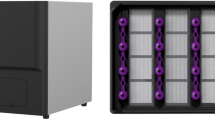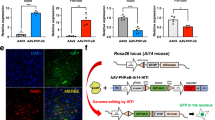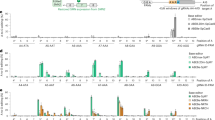Abstract
Spinal muscular atrophy (SMA) is a genetic neuromuscular disorder caused by mutations in the SMN1 gene. The homologous copy (SMN2) is always present in SMA patients. SMN1 gene transcripts are usually full-length (FL), but exon 7 is spliced out in a high proportion of SMN2 transcripts (delta7) (Δ7). Advances in drug therapy for SMA have shown that an increase in SMN mRNA and protein levels can be achieved in vitro. We performed a systematic analysis of SMN expression in primary fibroblasts and EBV-transformed lymphoblasts from seven SMA patients with varying clinical severity and different SMN1 genotypes to determine expression differences in two accessible tissues (skin and blood). The basal expression of SMN mRNA FL and Δ7 in fibroblasts and lymphoblasts was analyzed by quantitative real-time PCR. The FL-SMN and FL/Δ7 SMN ratios were higher in control cells than in patients. Furthermore, we investigated the response of these cell lines to hydroxyurea, valproate and phenylbutyrate, drugs previously reported to upregulate SMN2. The response to treatments with these compounds was heterogeneous. We found both intra-patient and inter-patient variability even within haploidentical siblings, suggesting that tissue and individual factors may affect the response to these compounds. To optimize the stratification of patients in clinical trials, in vitro studies should be performed before enrolment so as to define each patient as a responder or non-responder to the compound under investigation.
Similar content being viewed by others
Log in or create a free account to read this content
Gain free access to this article, as well as selected content from this journal and more on nature.com
or
References
Alias L, Bernal S, Fuentes-Prior P et al: Mutation update of spinal muscular atrophy in Spain: molecular characterization of 745 unrelated patients and identification of four novel mutations in the SMN1 gene. Hum Genet 2009; 125: 29–39.
Lefebvre S, Burglen L, Reboullet S et al: Identification and characterization of a spinal muscular atrophy-determining gene. Cell 1995; 80: 155–165.
Bussaglia E, Clermont O, Tizzano E et al: A frame-shift deletion in the survival motor neuron gene in Spanish spinal muscular atrophy patients. Nat Genet 1995; 11: 335–337.
Cusco I, Lopez E, Soler-Botija C, Jesus Barcelo M, Baiget M, Tizzano EF : A genetic and phenotypic analysis in Spanish spinal muscular atrophy patients with c.399_402del AGAG, the most frequently found subtle mutation in the SMN1 gene. Hum Mutat 2003; 22: 136–143.
Martin Y, Valero A, del Castillo E, Pascual SI, Hernandez-Chico C : Genetic study of SMA patients without homozygous SMN1 deletions: identification of compound heterozygotes and characterisation of novel intragenic SMN1 mutations. Hum Genet 2002; 110: 257–263.
Lorson CL, Hahnen E, Androphy EJ, Wirth B : A single nucleotide in the SMN gene regulates splicing and is responsible for spinal muscular atrophy. Proc Natl Acad Sci USA 1999; 96: 6307–6311.
Monani UR, Lorson CL, Parsons DW et al: A single nucleotide difference that alters splicing patterns distinguishes the SMA gene SMN1 from the copy gene SMN2. Hum Mol Genet 1999; 8: 1177–1183.
Gennarelli M, Lucarelli M, Capon F et al: Survival motor neuron gene transcript analysis in muscles from spinal muscular atrophy patients. Biochem Biophys Res Commun 1995; 213: 342–348.
Dodds E, Dunckley MG, Roberts RG, Muntoni F, Shaw CE : Overexpressed human survival motor neurone isoforms, SMNDeltaexon7 and SMN+exon7, both form intranuclear gems but differ in cytoplasmic distribution. FEBS Lett 2001; 495: 31–38.
Lorson CL, Androphy EJ : An exonic enhancer is required for inclusion of an essential exon in the SMA-determining gene SMN. Hum Mol Genet 2000; 9: 259–265.
Cusco I, Barcelo MJ, Rojas-Garcia R et al: SMN2 copy number predicts acute or chronic spinal muscular atrophy but does not account for intrafamilial variability in siblings. J Neurol 2006; 253: 21–25.
Feldkotter M, Schwarzer V, Wirth R, Wienker TF, Wirth B : Quantitative analyses of SMN1 and SMN2 based on real-time light cycler PCR: fast and highly reliable carrier testing and prediction of severity of spinal muscular atrophy. Am J Hum Genet 2002; 70: 358–368.
Chang JG, Hsieh-Li HM, Jong YJ, Wang NM, Tsai CH, Li H : Treatment of spinal muscular atrophy by sodium butyrate. Proc Natl Acad Sci USA 2001; 98: 9808–9813.
Kelly WK, O'Connor OA, Marks PA : Histone deacetylase inhibitors: from target to clinical trials. Expert Opin Investig Drugs 2002; 11: 1695–1713.
Andreassi C, Angelozzi C, Tiziano FD et al: Phenylbutyrate increases SMN expression in vitro: relevance for treatment of spinal muscular atrophy. Eur J Hum Genet 2004; 12: 59–65.
Brichta L, Hofmann Y, Hahnen E et al: Valproic acid increases the SMN2 protein level: a well-known drug as a potential therapy for spinal muscular atrophy. Hum Mol Genet 2003; 12: 2481–2489.
Sumner CJ, Huynh TN, Markowitz JA et al: Valproic acid increases SMN levels in spinal muscular atrophy patient cells. Ann Neurol 2003; 54: 647–654.
Grzeschik SM, Ganta M, Prior TW, Heavlin WD, Wang CH : Hydroxyurea enhances SMN2 gene expression in spinal muscular atrophy cells. Ann Neurol 2005; 58: 194–202.
Brahe C, Vitali T, Tiziano FD et al: Phenylbutyrate increases SMN gene expression in spinal muscular atrophy patients. Eur J Hum Genet 2005; 13: 256–259.
Brichta L, Holker I, Haug K, Klockgether T, Wirth B : In vivo activation of SMN in spinal muscular atrophy carriers and patients treated with valproate. Ann Neurol 2006; 59: 970–975.
Liang WC, Yuo CY, Chang JG et al: The effect of hydroxyurea in spinal muscular atrophy cells and patients. J Neurol Sci 2008; 268: 87–94.
Swoboda KJ, Scott CB, Reyna SP et al: Phase II open label study of valproic acid in spinal muscular atrophy. PLoS One 2009; 4: e5268.
Chen TH, Chang JG, Yang YH et al: Randomized, double-blind, placebo-controlled trial of hydroxyurea in spinal muscular atrophy. Neurology 2010; 75: 2190–2197.
Munsat TL, Davies KE : International SMA consortium meeting. (26–28 June 1992, Bonn, Germany). Neuromuscul Disord 1992; 2: 423–428.
Burglen L, Lefebvre S, Clermont O et al: Structure and organization of the human survival motor neurone (SMN) gene. Genomics 1996; 32: 479–482.
Soler-Botija C, Cusco I, Caselles L, Lopez E, Baiget M, Tizzano EF : Implication of fetal SMN2 expression in type I SMA pathogenesis: protection or pathological gain of function? J Neuropathol Exp Neurol 2005; 64: 215–223.
Mishell RI, Shiigi JM, Mishell BB, Grabstein KH, Shiigi SM : Prevention of the immunosuppressive effects of glucocorticosteroids by cell-free factors from adjuvant-activated accessory cells. Immunopharmacology 1980; 2: 233–245.
Simard LR, Belanger MC, Morissette S, Wride M, Prior TW, Swoboda KJ : Preclinical validation of a multiplex real-time assay to quantify SMN mRNA in patients with SMA. Neurology 2007; 68: 451–456.
Coovert DD, Le TT, McAndrew PE et al: The survival motor neuron protein in spinal muscular atrophy. Hum Mol Genet 1997; 6: 1205–1214.
Lefebvre S, Burlet P, Liu Q et al: Correlation between severity and SMN protein level in spinal muscular atrophy. Nat Genet 1997; 16: 265–269.
Patrizi AL, Tiziano F, Zappata S, Donati MA, Neri G, Brahe C : SMN protein analysis in fibroblast, amniocyte and CVS cultures from spinal muscular atrophy patients and its relevance for diagnosis. Eur J Hum Genet 1999; 7: 301–309.
Sumner CJ, Kolb SJ, Harmison GG et al: SMN mRNA and protein levels in peripheral blood: biomarkers for SMA clinical trials. Neurology 2006; 66: 1067–1073.
Helmken C, Hofmann Y, Schoenen F et al: Evidence for a modifying pathway in SMA discordant families: reduced SMN level decreases the amount of its interacting partners and Htra2-beta1. Hum Genet 2003; 114: 11–21.
Grozinger CM, Schreiber SL : Deacetylase enzymes: biological functions and the use of small-molecule inhibitors. Chem Biol 2002; 9: 3–16.
Pazin MJ, Kadonaga JT : What's up and down with histone deacetylation and transcription? Cell 1997; 89: 325–328.
Kernochan LE, Russo ML, Woodling NS et al: The role of histone acetylation in SMN gene expression. Hum Mol Genet 2005; 14: 1171–1182.
Xu C, Chen X, Grzeschik S, Ganta M, Wang C : Hydroxyurea enhances SMN2 gene expression through nitric oxide release. Neurogenetics 2011; 12: 19–24.
Davis T, Kennedy C, Chiew YE, Clarke CL, deFazio A : Histone deacetylase inhibitors decrease proliferation and modulate cell cycle gene expression in normal mammary epithelial cells. Clin Cancer Res 2000; 6: 4334–4342.
McGrath-Morrow SA, Stahl JL : G(1) Phase growth arrest and induction of p21(Waf1/Cip1/Sdi1) in IB3-1 cells treated with 4-sodium phenylbutyrate. J Pharmacol Exp Ther 2000; 294: 941–947.
Jergil M, Kultima K, Gustafson AL, Dencker L, Stigson M : Valproic acid-induced deregulation in vitro of genes associated in vivo with neural tube defects. Toxicol Sci 2009; 108: 132–148.
Hammond EM, Green SL, Giaccia AJ : Comparison of hypoxia-induced replication arrest with hydroxyurea and aphidicolin-induced arrest. Mutat Res 2003; 532: 205–213.
Dayangac-Erden D, Topaloglu H, Erdem-Yurter H : A preliminary report on spinal muscular atrophy lymphoblastoid cell lines: are they an appropriate tool for drug screening? Adv Ther 2008; 25: 274–279.
Hauke J, Riessland M, Lunke S et al: Survival motor neuron gene 2 silencing by DNA methylation correlates with spinal muscular atrophy disease severity and can be bypassed by histone deacetylase inhibition. Hum Mol Genet 2009; 18: 304–317.
Bernal S, Alias L, Barcelo MJ et al: The c.859G>C variant in the SMN2 gene is associated with types II and III SMA and originates from a common ancestor. J Med Genet 2011; 47: 640–642.
Mercuri E, Bertini E, Messina S et al: Randomized, double-blind, placebo-controlled trial of phenylbutyrate in spinal muscular atrophy. Neurology 2007; 68: 51–55.
Garbes L, Riessland M, Holker I et al: LBH589 induces up to 10-fold SMN protein levels by several independent mechanisms and is effective even in cells from SMA patients non-responsive to valproate. Hum Mol Genet 2009; 18: 3645–3658.
Tiziano FD, Pinto AM, Fiori S et al: SMN transcript levels in leukocytes of SMA patients determined by absolute real-time PCR. Eur J Hum Genet 2010; 18: 52–58.
Ebert AD, Yu J, Rose Jr FF et al: Induced pluripotent stem cells from a spinal muscular atrophy patient. Nature 2009; 457: 277–280.
Acknowledgements
This work was supported by FIS05-2416 (EA-R), CIBERER (LA) and GENAME Project (RM-H and SB) and by grants FIS 08-0729 and GENAME Project to EFT. We wish to thank the consenting parents and patients who made this study possible. We are indebted to Carolyn Newey for editing this manuscript, to Ignasi Gich for help with statistics and to Anna Carreras Nolla, Luis Carlos Navas, Lluis Puig and Ana López Ferrer for assistance in obtaining cell lines.
Author information
Authors and Affiliations
Corresponding author
Ethics declarations
Competing interests
The authors declare no conflict of interest.
Rights and permissions
About this article
Cite this article
Also-Rallo, E., Alías, L., Martínez-Hernández, R. et al. Treatment of spinal muscular atrophy cells with drugs that upregulate SMN expression reveals inter- and intra-patient variability. Eur J Hum Genet 19, 1059–1065 (2011). https://doi.org/10.1038/ejhg.2011.89
Received:
Revised:
Accepted:
Published:
Issue date:
DOI: https://doi.org/10.1038/ejhg.2011.89
Keywords
This article is cited by
-
Spinal Muscular Atrophy autophagy profile is tissue-dependent: differential regulation between muscle and motoneurons
Acta Neuropathologica Communications (2021)
-
Spinal muscular atrophy — insights and challenges in the treatment era
Nature Reviews Neurology (2020)
-
Overexpression of SMN2 Gene in Motoneuron-Like Cells Differentiated from Adipose-Derived Mesenchymal Stem Cells by Ponasterone A
Journal of Molecular Neuroscience (2019)
-
Transcript, methylation and molecular docking analyses of the effects of HDAC inhibitors, SAHA and Dacinostat, on SMN2 expression in fibroblasts of SMA patients
Journal of Human Genetics (2016)
-
Decay in survival motor neuron and plastin 3 levels during differentiation of iPSC-derived human motor neurons
Scientific Reports (2015)



